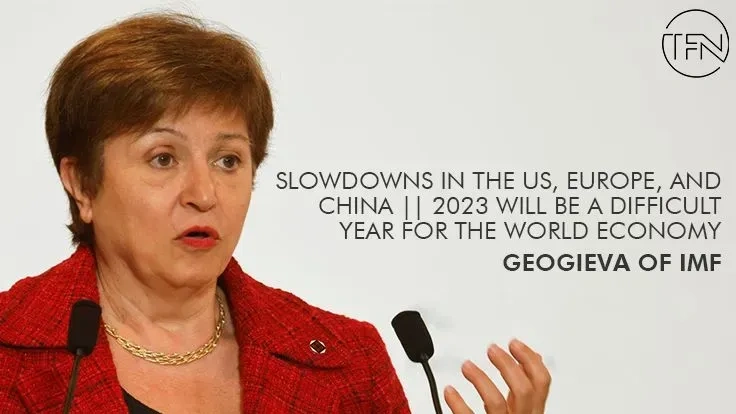
IMF Managing Director Kristalina Georgieva predicted that the next year will be "tougher than the year we leave behind" on the CBS Sunday morning news show "Face the Nation."
According to the director of the International Monetary Fund, 2023 will be a challenging year for most of the global economy as the primary drivers of global growth, the United States, Europe, and China, all see diminishing activity.
IMF Managing Director Kristalina Georgieva predicted that the next year will be "tougher than the year we leave behind" on the CBS Sunday morning news show "Face the Nation."
"Why? The US, EU, and China's three major economies are all slowing down at the same time "She said.
In addition to the continued negative consequences of the Ukraine war, inflationary pressures, and the high-interest rates imposed by central banks like the US Federal Reserve to combat such price pressures, the IMF reduced its prediction for global economic growth in 2023 in October.
Since then, China has abandoned its zero-COVID policy and started a chaotic economic recovery, but as coronavirus cases rise, customers are still scared. President Xi Jinping on Saturday urged for greater effort and unity as China enters a "new chapter" in his first public remarks since the policy shift.
For the first time in forty years, according to Georgieva, China's growth in 2022 "is anticipated to be at or below global growth."
Furthermore, Georgieva, who recently visited China on IMF business, predicted that a "bushfire" of anticipated COVID infections there in the coming months would likely severely hurt its economy this year and hinder regional and global development.
She said, "Last week I was in China, in a bubble in a city where there is 0% COVID. But if people start traveling, it won't be the case anymore."
She predicted that the next months would be difficult for China, which would have a detrimental effect on the country's progress as well as that of the region and the whole world.
Chinese GDP growth for 2018 was estimated by the IMF to have been 3.2% in its October prediction, which is comparable to the world prognosis for 2022. At that time, it was also observed that although global activity slowed further, China's yearly growth accelerated to 4.4% in 2023.
Her remarks, however, imply that another decrease in the growth outlooks for both China and the world might be in store for later this month, when the IMF usually releases new projections at the World Economic Forum in Davos, Switzerland.
In the meantime, according to Georgieva, the US economy is bucking the trend and may escape the complete collapse that might affect as many as a third of the world's countries.
The "US "may escape recession" because it is the most resilient, she said. The labor market is expected to continue relatively robust."
But that fact alone poses a concern since it may obstruct the Fed's efforts to reduce US inflation from the highest levels in four decades reached last year to its desired level. As 2022 ended, inflation began to show hints that it had peaked, but under the Fed's preferred metric, it is still close to three times its 2% objective.
This is "a mixed blessing," according to Georgieva since if the labor market is particularly robust, the Fed could need to maintain higher interest rates for a longer period to reduce inflation.
The Fed increased its benchmark policy rate from near zero in March to the current range of 4.25% to 4.50% last year in the most dramatic policy tightening since the early 1980s, and Fed policymakers predicted this month that it would exceed the 5% barrier in 2023, a level not seen since 2007.
Indeed, Fed policymakers will be concentrating their attention on the US labor market as they want to see a decline in the demand for labor to help temper price pressures.
A slew of significant employment-related data will be released in the first week of the new year, including Friday's nonfarm payrolls report, which is anticipated to show that the US economy added 200,000 jobs in December and that the unemployment rate stayed at 3.7%, which is close to the lowest level since the 1960s.

